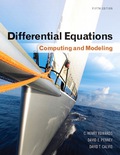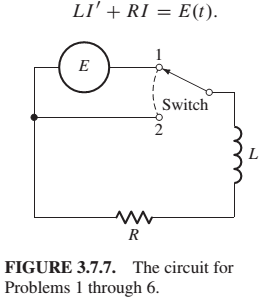
Problems 1 through 6 deal with the RL circuit of Fig. 3.7.7, a series circuit containing an inductor with an inductance of L henries, a resistor with a resistance of R ohms, and a source of electromotive force (emf), but no capacitor In this case Eq. (2) reduces to the linear first-order equation FIGURE 3.7.7. The circuit for Problems 1 through 6.

In the circuit of Fig. 3.7.7, with the switch in position 1, suppose that
Want to see the full answer?
Check out a sample textbook solution
Chapter 3 Solutions
EBK DIFFERENTIAL EQUATIONS
Additional Math Textbook Solutions
Thinking Like an Engineer: An Active Learning Approach (4th Edition)
Degarmo's Materials And Processes In Manufacturing
Introduction To Programming Using Visual Basic (11th Edition)
Concepts Of Programming Languages
Problem Solving with C++ (10th Edition)
Database Concepts (8th Edition)
- Write a C++ program that will count from 1 to 10 by 1. The default output should be 1, 2, 3, 4, 5, 6 , 7, 8, 9, 10 There should be only a newline after the last number. Each number except the last should be followed by a comma and a space. To make your program more functional, you should parse command line arguments and change behavior based on their values. Argument Parameter Action -f, --first yes, an integer Change place you start counting -l, --last yes, an integer Change place you end counting -s, --skip optional, an integer, 1 if not specified Change the amount you add to the counter each iteration -h, --help none Print a help message including these instructions. -j, --joke none Tell a number based joke. So, if your program is called counter counter -f 10 --last 4 --skip 2 should produce 10, 8, 6, 4 Please use the last supplied argument. If your code is called counter, counter -f 4 -f 5 -f 6 should count from 6. You should count from first to last inclusively.…arrow_forwardWrite a program that will count from 1 to 10 by 1. The default output should be 1, 2, 3, 4, 5, 6 , 7, 8, 9, 10 There should be only a newline after the last number. Each number except the last should be followed by a comma and a space. To make your program more functional, you should parse command line arguments and change behavior based on their values. Argument Parameter Action -f, --first yes, an integer Change place you start counting -l, --last yes, an integer Change place you end counting -s, --skip optional, an integer, 1 if not specified Change the amount you add to the counter each iteration -h, --help none Print a help message including these instructions. -j, --joke none Tell a number based joke. So, if your program is called counter counter -f 10 --last 4 --skip 2 should produce 10, 8, 6, 4 Please use the last supplied argument. If your code is called counter, counter -f 4 -f 5 -f 6 should count from 6. You should count from first to last inclusively. You…arrow_forwardWas What is the deference betwem full At Adber and Hold?arrow_forward
- I need help making this EER diagram in Chen Notation.arrow_forwardIn Java I have an input in a text file that I can't submit here. So, please use it as input.txtarrow_forwardPerceptual acuity, according to Ram Charan, explains how Ted Turner became the first CEO to recognize the potential of 24-hour news and thereby created CNN. a) True b) Falsearrow_forward
- As described in Learning from Mistakes, the failure of the A380 to reach its sales goals was due to Multiple Choice: a) misunderstanding of supplier demands. b) good selection of hotel in the sky amenities. c) changes in customer demands. d) lack of production capacity.arrow_forwardNumerous equally balanced competitors selling products that lack differentiation in a slow growth industry are most likely to experience high: a) intensity of rivalry among competitors. b) threat of substitute products. c) threat of new entrants. d) bargaining power of suppliers.arrow_forwardA Dia file has been created for you to extend and can be found on Company.dia represents a completed ER schema which, models some of the information implemented in the system, as a starting point for this exercise. Understanding the ER schema for the Company database. To demonstrate that you understand the information represented by the schema, explain using EMPLOYEE, DEPARTMENT, PROJECT and DEPENDENT as examples: attributes, entities and relationships cardinality & participation constraints on relationships You should explain questions a and b using the schema you have been given to more easily explain your answers. Creating and Extending Entity Relationship (EER) Diagrams. To demonstrate you can create entity relationship diagrams extend the ER as described in Company.dia by modelling new requirements as follows: Create subclasses to extend Employee. The employee type may be distinguished further based on the job type (SECRETARY, ENGINEER, MANAGER, and TECHNICIAN) and based…arrow_forward
- Computer programs can be very complex, containing thousands (or millions) of lines of code and performing millions of operations per second. Given this, how can we possibly know that a particular computer program's results are correct? Do some research on this topic then think carefully about your response. Also, explain how YOU would approach testing a large problem. Your answer must be thoughtful and give some insight into why you believe your steps would be helpful when testing a large program.arrow_forwardCould you fix this? My marker has commented, What's missing? The input list is the link below. https://gmierzwinski.github.io/bishops/cs321/resources/CS321_Assignment_1_Input.txt result.put(true, dishwasherSum); result.put(false, sinkSum); return result; }}arrow_forwardPLEG136: Week 5 Portofolio Project Motion to Compelarrow_forward
 C++ for Engineers and ScientistsComputer ScienceISBN:9781133187844Author:Bronson, Gary J.Publisher:Course Technology Ptr
C++ for Engineers and ScientistsComputer ScienceISBN:9781133187844Author:Bronson, Gary J.Publisher:Course Technology Ptr Operations Research : Applications and AlgorithmsComputer ScienceISBN:9780534380588Author:Wayne L. WinstonPublisher:Brooks Cole
Operations Research : Applications and AlgorithmsComputer ScienceISBN:9780534380588Author:Wayne L. WinstonPublisher:Brooks Cole Systems ArchitectureComputer ScienceISBN:9781305080195Author:Stephen D. BurdPublisher:Cengage Learning
Systems ArchitectureComputer ScienceISBN:9781305080195Author:Stephen D. BurdPublisher:Cengage Learning Principles of Information Systems (MindTap Course...Computer ScienceISBN:9781285867168Author:Ralph Stair, George ReynoldsPublisher:Cengage Learning
Principles of Information Systems (MindTap Course...Computer ScienceISBN:9781285867168Author:Ralph Stair, George ReynoldsPublisher:Cengage Learning C++ Programming: From Problem Analysis to Program...Computer ScienceISBN:9781337102087Author:D. S. MalikPublisher:Cengage Learning
C++ Programming: From Problem Analysis to Program...Computer ScienceISBN:9781337102087Author:D. S. MalikPublisher:Cengage Learning A Guide to SQLComputer ScienceISBN:9781111527273Author:Philip J. PrattPublisher:Course Technology Ptr
A Guide to SQLComputer ScienceISBN:9781111527273Author:Philip J. PrattPublisher:Course Technology Ptr





